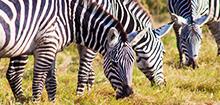
Date Published:
The Kenya Wildlife Service (KWS) led countrywide celebrations to commemorate World Rhino Day, simultaneously launching the Recovery and Action Plan for the Black Rhino, Friday, 22nd September, 2023 at the Club House in Nairobi National Park.
Speaking to celebrants during the event, the Cabinet Secretary Ministry of Tourism, Wildlife and Heritage, Hon. Peninah Malonza celebrated the milestones that Kenya has achieved in the conservation and management of rhinoceroses for the last three decades since the establishment of KWS in 1989. Hon. Malonza explained that there are 33 mammalian, 28 avian and 356 plant species in Kenya whose survival is threatened; the black rhino being one of them. The main threats emanate from human activities which include; climate change, habitat loss, fragmentation and degradation, poaching, illegal wildlife trade and human-wildlife conflict associated with land-use changes, coupled with impacts of climate change leading to unpredictable weather phenomena such as severe prolonged drought periods resulting in increased wildlife mortalities and cases of human wildlife conflict.
“My ministry is fast-tracking clearance of the pending compensation claims and providing necessary support to the communities which bear the brunt of wildlife,” CS Malonza said, adding that Kenya cannot overemphasize the fact that our wildlife and heritage are the main anchor to Kenya’s thriving tourism industry, offering significant support to community livelihoods which aligns to the Governments’ Bottom Up Economic Transformation Agenda.
Hon. Malonza said that the Government has developed relevant laws and policies and is a signatory to relevant Multilateral Environmental agreements (MEA’s) such the Convention on International Trade in Endangered Species of Wild Fauna and Flora (CITES) to ensure wildlife resources are secured for current and future generations. “Section 49 of the Wildlife Conservation and Management Act, 2013 gives KWS the mandate, in collaboration with stakeholders to develop and implement endangered species-specific recovery plans for species listed in the sixth schedule, such as the black and white rhinoceros, the CS stated.
The CS said that implementation of the past six editions of the action plan has enhanced the recovery of the black rhino populations to more than double, from the population of less than 400 individuals in 1989, to an estimated population of 1,890 rhinos (966 black, 922 white and 2 northern white rhinos) by the end of 2022, adding that Kenya’s black rhino population ranks 3rd after South Africa and Namibia and that we host approximately 80% of the eastern subspecies of the black rhino (Diceros bicornis michaeli).
Hon. Malonza assured attendees that the Government will continue to support KWS in implementing her mandate of conserving wildlife and their habitats, in collaboration with stakeholders to secure the future of Kenya’s wildlife, particularly the rhinoceros. This will be critical in achieving the new goal of boosting black rhino numbers by at least 5%, suppressing poaching below 0.5% and maintaining mortality from other causes to less than 0.5% p.a., to reach a confirmed national total of 1,200 black rhinos by the end of 2026.
The cabinet Secretary said that Kenya should learn lessons and improve her strategies and approaches in rhino conservation and management, by adopting novel technologies such as the use of drones and forensic evidence to enhance prosecutions, among others, adding that the Government has also allocated a budget in the current financial year to support the recruitment of more law enforcement officers. The CS lauded the timely creation of the Wildlife Research and Training Institute (WRTI) to focus on priority research programs to inform decision making processes in rhino conservation. She noted that successful implementation of this recovery plan will require concerted efforts by the National and County Governments, private and community conservancies, conservation partners as well as other stakeholders to ensure recovery of the species population and habitats.
“I wish to thank Kenya Wildlife Service staff and management, County Government of Narok, the private and community rhino areas and all partners and stakeholders in rhino conservation for the commitment and sacrifices made to achieve the milestones that we have made as a country,” CS said. She also thanked the IUCN Species Survival Commission, African Rhino Specialist Group (IUCN SSC AfRSG), Rhino Steering Committee (RSC) and Wild Wildlife Fund for Nature-Kenya (WWF-Kenya) for their continued support in rhino conservation.
Principal Secretary in the State Department for Wildlife Silvia Museiya said that World Rhino Day marks a significant moment in Kenya’s ongoing efforts to protect the black rhino, as the 7th edition of the Recovery and Action Plan for the Black Rhino (2022-2026) was launched. She added that rhinos are classified as Critically Endangered by the International Union for Conservation of Nature (IUCN) and listed under the Convention on International Trade in Endangered Species of Wild Fauna & Flora (CITES) Appendix I, due to the challenges confronting this species. “However, we have not wavered in our commitment to protect and preserve these remarkable creatures,” she affirmed.
Museiya noted that the journey to safeguard black rhinos has been a long and arduous one; nevertheless, it has been marked by remarkable progress. One pivotal moment in this journey is the Wildlife Conservation and Management Act (WCMA), 2013 which introduced enhanced penalties for wildlife crimes especially the critically endangered species listed in the sixth schedule. This, combined with the unwavering efforts of the local and international community, has led to significant strides in the fight against the illegal wildlife trade and, importantly in reducing rhino poaching in Kenya.
The PS said that Kenya's 7th edition of the Recovery and Action Plan for the Black Rhino (2022-2026) is a testament to Kenya’s determination to protect and restore this iconic species. She said It is aligned with the National Wildlife Strategy 2030, The Wildlife Policy of 2020 and other relevant national laws and policies, and Multilateral Environmental agreements (MEA’s) that Kenya is a signatory to, which reflect a united front in our mission. The PS lamented the impacts of climate change which have led to unpredictable seasons, prolonged droughts and resource constraints for rhino habitats, adding that the Ministry, is committed to supporting KWS in implementation of the identified activities and priority projects, especially rhino range expansion to address increased mortalities from territorial fights and suppressed growth rates due to constrained space.
“In this endeavour, we are encouraged by the renewed interest from private and community landowners to join hands with the government in rhino conservation. This collaboration will significantly contribute to expanding the rhino range. We are committed to realizing the potential for expanding existing areas and especially securing the Tsavo West National Park Intensive Protection Zone (IPZs) which has the capacity to host a large number of rhinos to ensure the long-term survival of this iconic species”, she concluded.
KWS Board of Trustee Chairman Lt. Gen. (Rtd.) Walter Koipaton expressed gratitude to the CS, KWS staff and partners for their support in achieving the launch of the 7th edition of The Recovery and Action Plan for the Black Rhinoceros in Kenya. The Chairman said that while general conservation was of utmost importance, there was a need to zero in on endangered species to prevent their extinction. The retired Lt. Gen said that communities living adjacent to wildlife form a critical part in joined rhino conservation efforts, adding that conservation policies must favour both the rhinos and communities.
The Chairman stressed on the need to secure more land for rhinos to avoid territorial fatalities, even as he appreciated KWS management’s efforts in curbing rhino poaching which resulted in a remarkable zero rhinos poached in the year 2020. Lt. Gen. (Rtd.) Koipaton commended rangers who brave all manner of challenges to conserve the rhino, stressing on the introduction of sustainable ranger retention programs to keep the conservation trajectory stable. He said there is urgent need to increase surveillance in protected areas..
KWS Director General Dr. Erustus Kanga said that this year’s World Rhino Day was meant to prompt Kenya to reflect on her rhino conservation milestones under the leadership of KWS. Dr. Kanga said that the 6th edition saw major wins, such as the attaining of very low rhino poaching levels, exemplified by the year 2020, when zero poaching levels were recorded. “We celebrate KWS rangers and managers and our conservancy partners for their alertness which saw this historic feat achieved,” he said, adding that rhino population numbers saw an unprecedented surge. This happy circumstance however, presented a challenge in limited space for the rhinos, which led to the rapid development of the 7th edition of the Recovery and Action Plan for the Black Rhino, to tackle the emergent challenges for the rhino populations.
Dr. Kanga mentioned four key pillars in this 7th edition: enhancing law enforcement, acquiring more space for wildlife for the territorial rhinos in Laikipia and Tsavo landscape, the use of technology to monitor rhinos all over Kenya and increasing consultative conservation, giving an example of the deliberate efforts made to save the Northern White Rhino from extinction. The DG thanked the CS, the Ministry, the County Government of Narok and private and community rhino areas for continued support in wildlife conservation and the rallying call to manage the environment sustainably to mitigate the effects of climate change, in addition to committing space and resources for rhino conservation.
Dr. Kanga also thanked partners, in particular, WWF for their commitment in support for the various rhino conservation activities, particularly the review of the 6th edition and the development of the 7th edition of the recovery and action plan.
The Director, Wildlife Research and Training Institute, Dr. Patrick Omondi, congratulated CS Malonza and Dr. Kanga for their success in rhino conservation, while also recognizing the challenges still present across Africa and Asia. He stated that WRTI is the support engine to KWS and her partners committing to continued collaboration to ensure that critically endangered species do not become extinct.
He averred that WRTI would provide research and information and real time data to further rhino conservation. Dr. Omondi explained that Kenya has signed international treaties geared to the stoppage of rhino horn use as medicine, because the horn is made up of the same material that comprises human nails, stressing that even the World Health Organization had said rhino horn has no medicinal use whatsoever.
Other partners who addressed attendees to the 2023 World Rhino Day were, a WWF CEO representative, Mr.Kiplangat, the Chairman of the Association of Private and Community Land Rhino Sanctuaries, Jaymie Gaymer and KWS Head of Conservation Science Program, Solomon Kyalo.
WRD 2023 Facts
- Black rhino populations are increasing despite constant threats.
- With all five species combined, there are just over 26,000 rhinos left in the world.
- International Theme: “Keep the five species of rhinos alive”
- Kenya’s theme: “Securing the future for rhinos though enhanced stakeholder collaboration”
- Currently there are 5 species of rhinoceros remaining in the world found in their natural range in Africa and Southern Asia, though some individuals are found ex situ in other continents mainly in zoos. The five species are; Black rhino (6,195), White rhino (15,942), Greater one-horned (4,014), Sumatran (34-47) and Javan rhinos (76). Greater one-horned, Sumatran and Javan rhinos are found in Asia while Black and White rhinos are in Africa.
- The black rhinos have doubled from less than 400 individuals in 1989 when KWS was established to current population estimate of 990 individuals by August 2023.
- The southern white rhino population has increased from approximately 50 individuals introduced from South Africa in the 80’s-90’s to the current population estimate of 950 individuals.
- Kenya hosts the last two (2) known living northern white rhino females, Najin 33 years old and her daughter Fatu 23 years old.





